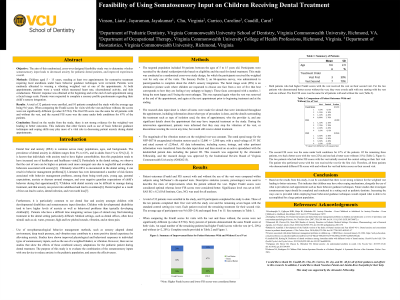Patient Management
277 - Feasibility of Using Somatosensory Input on Children Receiving Dental Treatment


Liara D. Vinson, DDS (she/her/hers)
2nd Year Resident
Virginia Commonwealth University, Richmond, VA
Richmond, Virginia, United States- CC
Caroline K. Carrico, PhD
Virginia Commonwealth University School of Dentistry
- CC
Carol Caudill, Assistant Professor
Virginia Commonwealth University School of Dentistry
- VC
Virginia Chu, PhD, MS
Virginia Commonwealth University College of Health Professions
- JJ
Jayakumar Jayaraman, BDS, MDS, FDSRCS, MS, PhD
Virginia Commonwealth University School of Dentistry
- CC
Carol Caudill, DDS
Director, Predoctoral Pediatric Dentistry Assistant Professor, Pediatric Dentistry
Virginia Commonwealth University School of Dentistry
Richmond, Virginia, United States - TW
Tiffany Williams, DDS, MSD, FACD
Program Director, Pediatric Dental Residency
Virginia Commonwealth University
Richmond, Virginia, United States
Presenting Author(s)
Co-Author(s)
Research Mentor(s)
Program Director(s)
Purpose: The aim of this randomized, cross-over designed feasibility study was to determine whether somatosensory input leads to decreased anxiety for pediatric dental patients, and improved experiences overall.
Methods: Children aged 5 - 15 years, needing at least two appointments for restorative treatment requiring local anesthesia under basic behavior guidance techniques were recruited. Patients were randomly allocated to wearing a vibrating weighted vest at one of the appointments. At both appointments, patients wore a watch which measured heart rate, electrodermal activity, and skin conductance. Patients' response was obtained at the beginning and at the end of each appointment using a facial image scale. Parents were requested to complete a sensory profile questionnaire regarding their child’s sensory integration.
Results: A total of 32 patients were enrolled, and 10 patients completed the study with the average age being 9.6 years. When comparing the Frankl scores for visits with the vest and those without, the scores were not significantly different (p-value=0.5724). The first FIS score was the same for all patients with and without the vest, and the second FIS score was the same under both conditions for 67% of the patients.
Conclusion: Based on the results from the study, there is not strong evidence for the weighted vest leading to better outcomes. This indicates that other factors such as use of basic behavior guidance techniques and coping skills may play more of a vital role in decreasing patient anxiety during dental appointments.
Identify Supporting Agency and Grant Number: “Research supported by the Alexander Fellowship”

.jpg)